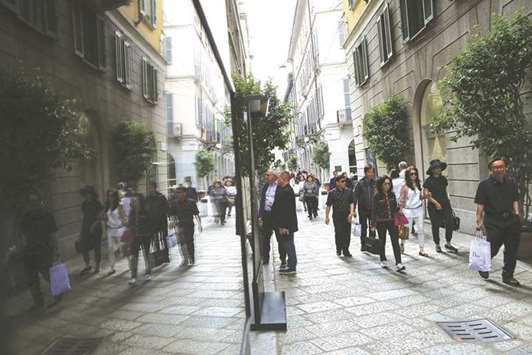The euro-area economy maintained its robust growth pace at the end of last year, setting the stage for another solid performance in 2018 that may sway European Central Bank policy makers into winding down unprecedented stimulus.
Gross domestic product increased 0.6% from the previous three months, Eurostat reported Wednesday, confirming a January 30 estimate. Growth slowed in Germany and Italy, while the pace of expansion accelerated in the Netherlands and Portugal, according to separate reports.
The European Commission has said the economic expansion in the 19-nation region is now more balanced than at any time since the financial crisis, and the International Monetary Fund has raised its global outlook for 2018. ECB policymakers say they’re increasingly confident that robust growth will slowly rekindle price pressures, paving the way for a gradual withdrawal of monetary accommodation.
Germany’s upswing — despite a slowdown in quarterly output — continues to be a key ingredient for growth in the euro area. Momentum in the country at the end of last year was driven by a strong increase in exports, according to a national report. Government consumption and equipment investment increased, while private spending remained largely unchanged and construction slipped.
The Dutch economy also benefited from buoyant global trade. GDP increased 0.8% in the fourth quarter, exceeding economist estimates.
Italian growth slowed to 0.3%, leaving it lagging behind France and Germany and providing a note of caution ahead of general elections next month.
The 0.3% pace was weaker than the previous three months and below the 0.4% median forecast in a Bloomberg survey. It leaves full-year expansion at an estimated 1.4%, statistics office Istat in Rome said yesterday, less than the government’s recent estimate of 1.5%.
While the government can point to continued growth as a sign that its policies are working, opposition parties are focusing on the fact that the recovery isn’t being felt evenly. With the election less than three weeks away, issues such as job security, tax burden and immigration remain high in the political debate.
The fourth-quarter growth was limited by “a fall in the added value of agriculture” while manufacturing and services rose thanks to the domestic demand and exports, Istat said in the report.
The Istat report comes before general elections that opinion polls project will end in a hung parliament, with the risk of a repeated vote within few months. Istat will release a preliminary estimate of the GDP growth for full-year 2017 on March 1, three days before the election.
The euro region’s third-biggest economy will expand 1.5% this year, the European Commission said in a report last week. That means Italy will lag behind all euro-area member nations this year.
“Even though Italy’s economy expanded more slowly than expected in the final quarter of 2017, the speed of growth was still fast enough to chisel away at spare capacity. Plenty of work remains to be done, but the economy should continue the long process of healing from the euro crisis next quarter,” Bloomberg economists including David Powell and Jamie Murray said.
Italy’s industrial production rose 0.8% in the fourth quarter, Istat said in a separate report earlier this month. It showed a 1.9% growth in the output of machinery and equipment over the period that economists say was made possible by increasing domestic and foreign demand.
The Italian economy rose 1.6% in the fourth quarter from the same period of 2016, Istat also said.
GDP increased 0.7% in Portugal.
“Going into this year there are reasons to expect growth to broaden,” said Jennifer McKeown, chief European economist at Capital Economics Ltd in London. “Germany will likely be among the strongest performers this year, but as you move through the year France and Italy will hopefully start to catch up.”
Elsewhere, the Japanese economy continues to look healthy after two years of uninterrupted growth, even though growth slowed to 0.1% in the fourth quarter amid weaker public demand. Singapore lost some of its momentum at the end of 2017, with the government projecting a slight moderation in growth this year as an export boom eases. Economic momentum in the euro area surged to the fastest pace in almost 12 years last month, a business survey showed, pushing firms to pile on the most additional workers since the start of the millennium.
“Eurozone industry is a good example of a sector with still a lot of upside left,” Bert Colijn, senior euro-area economist at ING Bank NV in Amsterdam, said after a report showed industrial output surged an annual 5.2% in December. “The acceleration of production growth is unlikely to be a one-off as the outlook for industry remains rosy.” While ECB President Mario Draghi has welcomed the region’s strengthening momentum, he also cautioned against removing stimulus too quickly in light of still-muted inflation. Consumer-price growth slowed to the weakest since July at the start of the year.
“The GDP results for the final quarter of 2017 should strengthen confidence at the ECB that inflation will gradually move from 1.3% currently to the goal of just below 2%,” said Alexander Krueger, chief economist at Bankhaus Lampe KG in Dusseldorf.

Shoppers are reflected in glass as they walk in central Milan. Italy’s economic growth slowed to 0.3%, leaving it lagging behind France and Germany and providing a note of caution ahead of general elections next month.
